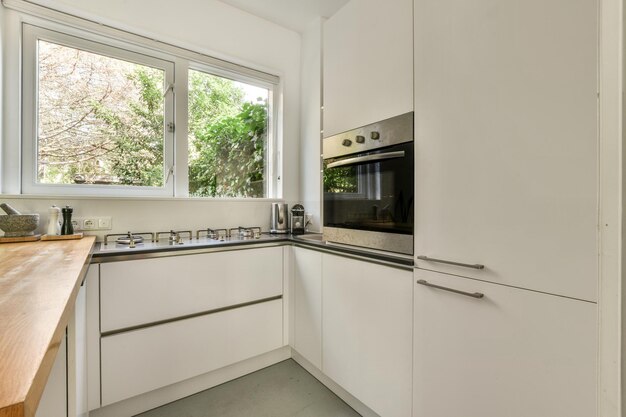How to Seamlessly Integrate a Panel-Ready Refrigerator Into Your Countertop Depth Space
Tired of your kitchen's outdated look and want to revolutionize it with sleek, modern appliances? Imagine a kitchen where your refrigerator blends effortlessly with your cabinetry, making your space feel cohesive and sophisticated. This dream can become a reality by properly integrating a panel-ready refrigerator into your countertop depth. Let’s explore how you can achieve this seamless look and what you should consider before embarking on this transformation.
Why Go for a Panel-Ready Refrigerator?
Panel-ready refrigerators are designed to accommodate custom cabinet panels, allowing them to merge seamlessly with the rest of your kitchen cabinetry. Here are a few reasons why you might want to consider this option:
- Aesthetics: These refrigerators maintain a uniform appearance, enhancing your kitchen's visual appeal by integrating the appliance with cabinetry.
- Flexibility: You have the creative liberty to match your refrigerator with any cabinet style and color, giving you a personalized touch.
- Resale Value: A professionally integrated kitchen design can also increase your home's resale value by appealing to discerning buyers.
Understanding the Basics of Panel-Ready Refrigerators
Before diving into the integration process, it's essential to understand what sets panel-ready refrigerators apart:
- Design: Unlike traditional refrigerators, panel-ready versions have exposed hinges and edges that allow for custom panel installation.
- Customization: They permit the use of custom cabinet panels that match your kitchen's color scheme and style.
- Installation Specifics: These refrigerators often require precise installation to align with adjacent cabinetry, making professional assistance advisable.
Essential Factors in Choosing a Panel-Ready Refrigerator
When deciding on a panel-ready option, consider these critical factors:
- Dimensions: Ensure the refrigerator's measurements align with your planned cabinet space.
- Capacity and Features: Consider the size and essential features such as energy efficiency, shelving options, and temperature control.
- Compatibility: Verify that your cabinets can accommodate the doors' full swing and that nearby drawers or doors won’t obstruct them.
Steps to Integrate a Panel-Ready Refrigerator
Now that you understand the fundamentals, let’s get into the process of integrating your panel-ready refrigerator within your kitchen design.
Step 1: Assess the Kitchen Layout
Evaluate your current kitchen layout. Measure the existing space and consider if any modifications to the cabinetry or countertop will be needed. Think about the flow of traffic and ensure the design allows for easy accessibility and convenience.
Step 2: Choose the Right Refrigerator
Select a panel-ready refrigerator that fits your desired space. It’s crucial to ensure that the refrigerator’s depth aligns with your countertop depth to avoid protrusion. When shopping, consider brands that offer detailed specs or visualizations to aid your planning.
Step 3: Design the Panel
Work with a cabinet maker to design custom panels that match or complement your kitchen’s aesthetic. Whether going for a classic wood finish or a modern glossy look, the design should be consistent with the overall theme.
Step 4: Prepare the Space
Before installation, prepare the space. This might involve removing existing cabinetry, making slight adjustments to accommodate your new appliance, and ensuring any plumbing or electrical work is adjusted for compatibility with the new refrigerator.
Step 5: Installation
While some handy homeowners may want to attempt installation themselves, it's often best left to professionals. They can ensure that the refrigerator is properly aligned and that all connections are secure, providing peace of mind and a polished finish.
- Align Panels: Properly attach the panels to ensure a flush and seamless appearance.
- Check Alignment: Ensure the refrigerator and panels line up with the adjacent cabinets and countertops.
Controls & Settings: Ensuring Optimal Performance
Once your refrigerator is integrated, it's essential to focus on controls and settings to maintain its efficiency and functionality.
Controlling Temperature
Ensure temperatures are set correctly for both the fridge and freezer compartments:
- Fresh Food: Typically, set between 35°F and 38°F for optimal freshness without freezing.
- Freezer: Ideal settings are around 0°F for maintaining frozen goods.
Humidity and Airflow
- Humidity Controls: Some panel-ready refrigerators come with humidity-controlling drawers, perfect for prolonging the life of vegetables and fruits.
- Airflow: Ensure there is adequate airflow around the appliance to prevent overheating and inefficiency.
Energy Efficiency Settings
Modern refrigerators often come with eco-friendly settings. Activating these can help minimize energy usage and reduce costs over time.
Common Pitfalls and How to Avoid Them
Integration can be a complex process if not approached carefully. Here are common pitfalls and tips on how to avoid them:
Inadequate Planning
Failing to plan can result in a refrigerator that protrudes or conflicts with surrounding cabinets. Always double-check measurements and consult with a professional designer if necessary.
Poor Panel Installation
Misaligned or poorly attached panels can detract from the refrigerator’s aesthetic appeal. Use a skilled installer to achieve smooth, professional results.
Ignoring Ventilation Needs
Refrigerators require proper ventilation, often necessitating a slight gap between the appliance and the cabinetry. Ensure pre-installation checks accommodate these needs to prevent overheating.
🌟 Quick Reference: Key Integration Tips & Tricks
Here's a concise list of tips to guide your journey to a seamlessly integrated kitchen:
- 🛠️ Measure Twice: Double-check all measurements to ensure precise fitting.
- 🎨 Design Cohesion: Choose panel designs that enhance your kitchen’s theme.
- 👨🔧 Expert Assistance: Employ professional installers for perfect alignment.
- 🔧 Adequate Spacing: Ensure proper ventilation to optimize refrigerator performance.
- 🧊 Control Mastery: Familiarize yourself with temperature and efficiency settings.
By diligently following these guidelines, you can transform your kitchen into a harmonious, stylish enclave featuring a beautifully integrated panel-ready refrigerator. Not only will this upgrade bring visual pleasure and enhanced functionality, but it will also add substantial value to your home.
